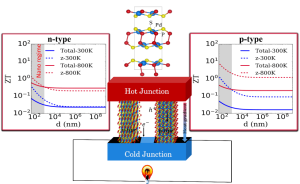Currently, the energy sector is facing two major challenges: first, the scarcity of conventional energy sources, and second, the demand for clean and environment-friendly energy sources. To address these two difficulties, the thermoelectric power generator promises to be one of the most attractive alternatives.
The thermoelectric generator can produce power from waste heat energy, so it can reduce the consumption of energy in large energy-consuming sectors, such as the automobile sector, and industry. So far, however, low efficiency of the thermoelectric generator has blocked its application on a vast commercial scale.
In a recently published article in Physica Status Solidi B, scientists from India have predicted a novel thermoelectric material, palladium ph osphide sulphide.
osphide sulphide.
By using density functional theory and the Boltzmann transport equation, this paper predicts high anisotropic thermoelectric properties in three crystallographic directions and ultra low thermal conductivity in Z crystallographic direction. This material shows a high thermoelectric figure of merit in the nanosize regime.
Worldwide, scientists are working to find a non-toxic material which can be used in the thermoelectric device. If properly doped, this material can suffice to work as both p-type and n-type leg of the thermoelectric generator, and will also be highly advantageous for designing a thermoelectric device where the p-type and n-type legs are connected in series electronically, and in parallel thermally.
Image credit: saicle/Getty Images

















